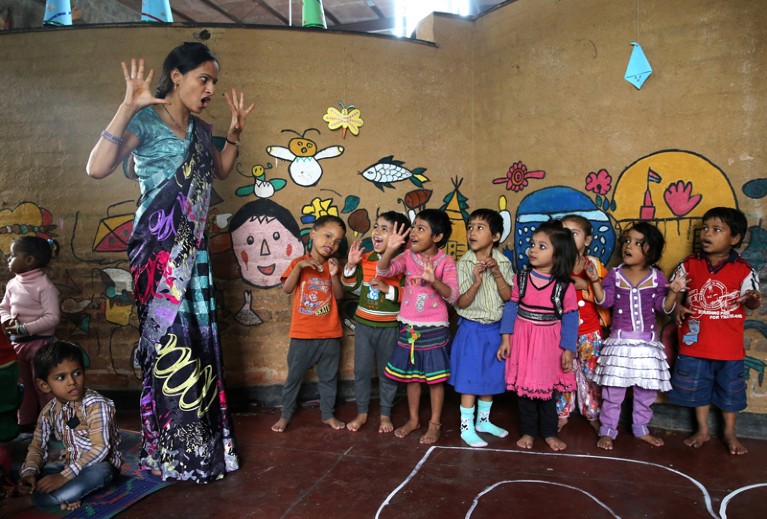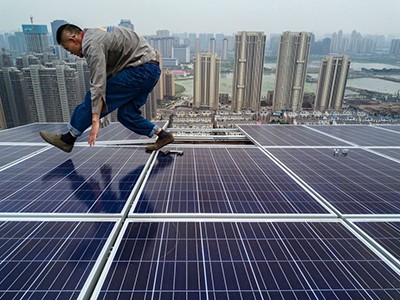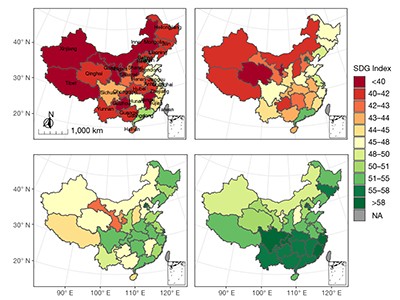
Getting children into primary schools is within reach, but most of the Sustainable Development Goals will not be met by 2030 on current trends.Credit: Chris Jackson/Getty
In 2015, world leaders met in New York at a landmark conference of the United Nations. Their aim: to end poverty, stop environmental destruction and boost well-being. In the world of multilateral diplomacy, such meetings are not uncommon, but they tend to focus on individual areas, such as climate change or food security. The 2015 summit was different because heads of state and governments pledged concrete action across an integrated set of economic, environmental and social issues. They signed up to the Sustainable Development Goals (SDGs), a package of 17 goals and associated targets for ending hunger, eliminating extreme poverty, reducing inequality, tackling climate change and halting the loss of biodiversity and ecosystems — all by 2030.
With that deadline now a decade away, the world is set to miss most of the SDGs. Just two of them — eliminating preventable deaths among newborns and under-fives, and getting children into primary schools — are closest among all the goals to being achieved. By contrast, the goal to eliminate extreme poverty will not be met because some 430 million people are expected still to be living in such conditions in 2030.
Targets to end hunger and to protect climate and biodiversity are completely off track. Whereas some of the richer countries are making a degree of progress in the SDGs overall, two-thirds of poorer ones are not expected to meet those that relate even to their most basic needs.
A better way for countries to track their progress on sustainability
The SDGs are extremely valuable, and five years is too short a time to see real progress towards economic transformation, which must happen if the goals are to be achieved in full. But at the same time, the SDGs have had a considerable positive impact — including in research and higher education. Institutions globally are signing up to supporting the SDGs, and staff and students are taking on responsibilities, from eliminating single-use plastic, to switching to renewable energy. The goals’ cross-cutting nature has fuelled research, too, providing scientists with opportunities in the fields of the environment, engineering, health policy, development economics and beyond.
But these bright spots cannot mask what is still a bleak trend. The UN secretary-general, António Guterres, puts the halting progress down to a lack of funding — especially from the governments of developed countries. The goals come with a price tag of between US$5 trillion and $7 trillion per year, and the shortfall has been put at $2.5 trillion.
But there’s a larger obstacle. The goals are still a voluntary effort, although monitoring of progress is extensive. A UN-affiliated organization called the Sustainable Development Solutions Network produces an annual report that shows how well countries are performing on the SDGs, and, in a paper in Nature this week, researchers from the United States and China describe how progress can be more accurately recorded (Z. Xu et al. Nature 577, 74–78; 2020). But it’s not compulsory for countries to report how they are doing.
Read the paper: Assessing progress towards sustainable development over space and time
To be achieved, the SDGs need to become mandatory — not necessarily in the legal sense, but in the sense that nations have to know that there’s no alternative but to make them happen. One analogy is the way in which countries report their economic data. There’s no international law that says every country must report data, such as on consumer spending, that go into calculating its gross domestic product (GDP). But for more than 50 years, these data have been collected at a granular level and are now reported every quarter by national statistics offices. Every agency of government understands that a nation’s economy must always be seen to be growing, and so the data underlying the GDP must also always be increasing. That’s why there’s a massive national effort to make sure that everyone works towards what could be called the ‘GDP goals’. The SDGs are unlikely to be achieved unless they, too, sit at the apex of a similar national effort.
At the same time — and as is often pointed out — some GDP goals are in opposition to sustainability efforts such as the SDGs. Take new sources of fossil-fuel energy. They provide much-needed power for communities lacking basic needs and contribute positively to economic growth. But they also have a negative impact on the environment and on human health. Yet it’s only the positive economic impact that counts in official data, and that is one reason — although not the only one, by far — why it’s proving so difficult to shift power to renewable-energy platforms. One solution might be to factor the cost of degrading the environment into national accounting — although there is as yet little consensus on how this would be done.
Tighter focus
One research-led effort where there is more consensus is the Global Sustainable Development Report (GSDR). Due to be published every four years, it is commissioned by the UN secretary-general and written by a team of 15 authors nominated by UN member states, but working independently with the wider scientific community. The first report was published last September, and the UN will appoint authors for the second one, due in 2023, later this month.
The first report’s authors are aware that the SDGs lack a mandatory reporting mechanism, and that in some cases the goals are competing with GDP goals. And they have come up with an innovative solution. They recommend that nations consider redistributing the 17 SDGs into 6 ‘entry points’. These are: human well-being (including eliminating poverty and improving health and education); sustainable economies (including reducing inequality); access to food and nutrition; access to — and decarbonizing — energy; urban development; and the global commons (combining biodiversity and climate change).
This is a sensible recommendation. A focus on a smaller, more integrated set of goals could help to reduce instances in which implementing one of the SDGs has the potential to hinder another. Take the case of wind energy. This has a part to play in meeting the climate action SDG, but if wind farms are sited in the wrong places, or if the turbines are the wrong height, they can potentially harm bird populations, which would affect the SDG on protecting biodiversity and ecosystems. Under the GSDR proposals, climate and biodiversity would sit under one category for action. If properly implemented, this would mean that decisions on new energy sources would need to consider the implications for biodiversity — reducing the numbers of wind power plants that end up in inappropriate locations.
So how could the GSDR’s recommendations be implemented? So far, it’s not clear that they have reached the ministries of finance and economics, and the central banks, where they need to be heard. Last month, Guterres appointed the departing Bank of England governor Mark Carney as UN climate envoy. That is a positive move because Carney’s office has the potential to expand the report’s footprint by creating a formal link between the GSDR team and economic policymakers.
As the 15 scientists tasked with preparing the next report take their posts, they must also urge Guterres to give them the resources to raise the profile of their work further, so that it becomes as well known and influential as the UN reports on climate and biodiversity.
The SDGs were launched in a 2015 UN report called Transforming our World. That’s because a world without hunger and disease, with meaningful jobs and a clean environment, requires transformational change. But, on present trends, there are few signs that such change will be achieved by 2030. That’s a reason to redouble policy efforts guided by evidence. Real change won’t come until the research–policy interface is strengthened. Time is short, and there’s a lot to do when a decade is all we have.

 A better way for countries to track their progress on sustainability
A better way for countries to track their progress on sustainability
 Read the paper: Assessing progress towards sustainable development over space and time
Read the paper: Assessing progress towards sustainable development over space and time
 Time to leave the GDP behind
Time to leave the GDP behind
 Sustainable Development Goals: Are we successful in turning trade-offs into synergies
Sustainable Development Goals: Are we successful in turning trade-offs into synergies
 Biodiversity’s contribution to sustainable development
Biodiversity’s contribution to sustainable development
 Six transformations to achieve the sustainable development goals
Six transformations to achieve the sustainable development goals







